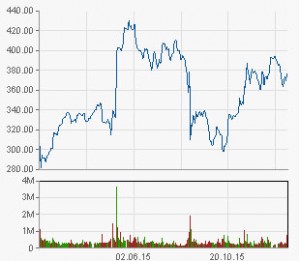Cumulative Assessment Groups: new EFSA publications
The story is going on: EFSA published two ‘external’ scientific reports with relevance in the field of cumulative risk assessment (CRA). As a prerequisite for CRA, chemical substances that may have harmful effects to consumers have to be grouped in so called Cumulative Assessment Groups (CAGs), based on their effects to target organs (common adverse effects). Up to now, two CAGs are established in the EU, based on effects on the nervous and thyroid systems. These CAGs defined so far include >100 substances.
Let’s come to the new publications:
- Title: MCRA made scalable for large Cumulative Assessment Groups (EFSA Supporting publication 2016:EN-910, published 27 January 2016).
- Using data provided by EFSA, it was shown that the web-based software tool MCRA allows Screening to run a large CAG of 96 compounds.
- MCRA 8.1. has been implemented in the flexible environment for high-performance computing at RIVM (Dutch National Institute for Public Health and the Environment).
- Contributions to the exposure results can be seen both in terms of food-as-eaten (e.g. white bread) and foods-as-measured (e.g. wheat).
- Drill-down can be made into the exact foods and compounds contributing for simulated individuals or individual-days in the upper tail of exposure. MCRA is probabilistic, and the exposure of 1 Million individuals can be simulated. You will find exposures exceeding toxicologigal reference values (ADI, ARfD), and with the drill-down you can identify the person-days exceeding these toxicoliocigal reference values of intake. The risk assessment is done by risk assessors (such as the EFSA, industry or consultants), the acceptability of the exposure is decided by risk Managers (EU commission).
- Title: Toxicological data collection and analysis to support grouping of pesticide active substances for cumulative risk assessment of effects on the nervous system, liver, adrenal, eye, reproduction and development and thyroid system (EFSA Supporting publication 2016:EN-999., published 17 February 2016).
- Contributing institutions: RIVM (Dutch National Institute for Public Health and the Environment), ICPS (International Centre for Pesticides and Health Risk Prevention), ANSES (French agency for food, environmental and occupational health & safety).
- The report provides news to the data collection (according to the methodology agreed
by EFSA, 2013) required for the establishment of new CAGs The spreadsheets with the reviewed data are available on the EFSA website.
- Based on the collection table of each organ/system, preliminary CAGs have been proposed by the consortium. From the active substances scrutinised, the GAGs include:
- Nervous system: 67 out of 129 substances,
- Thyroid: 57 out of 129 substances,
- Reproductive and development system: 124 out of 129 substances,
- Liver: 106 out of 129 substances,
- Adrenal system: 96 out of 416 substances,
- Eye: 79 out of 416 substances.
It must be kept in mind that certain substances may be included in several CRAs. This approach follows the concept of effects to target organs, i.e. dose addition. This concept does not cover the field of common metabolites, such as in the group of triazole fungicides.
My opinion: as risk assessors, we will be confronted with cumulative RA by end 2016/early 2017. I see a demanding task well implemented by EFSA and national institutions. Dietary (or better: ‘consumer’, since it will include intake by biocides and other sources) RA will implement a lot of work for calculations and reporting. Interestingly, model calculations have shown that the exposure by biocides in home-use is much more relevant than the exposure by food intake. A big discussion is going on for the setting of MRLs for biocidal products. However the border between agrochemical products, biocides and veterany health products is not cleary defined.
To finalise this post: I recently did a search for “glyphosate mode of action” in google. A webpage popped up: https://netzfrauen.org. Very interesting, especially the following statement:
[Zwischenbemerkung der Übersetzerin: Bei manchen Übersetzungen kann ich als Übersetzer nur kotzen. Dies ist ein Beispiel dafür. „Glyphosat schützt den Boden“ … wer so etwas behauptet, hat noch nie das Sterben eines Ackers nach einer Glyphosatbehandlung gesehen … sämtliche Pflanzen sind … tot. Gesunde Kräuter wie Kamille, Löwenzahn, Rotklee – alles weg. Und da sollen die so wichtigen Mikroorganismen des Bodens überleben? Organismen, die nun wirklich wichtig für die Qualität der Humusschicht sind? Wie absurd ist das denn?]
Well, I am very interested in easy solutions, whereever these are applicable. But i know that these are not available in the field of food production and safety for a growing population. I am critical against pesticides and companies involved in agrochemistry. But we should discuss with arguments, not with emotions. I ask myself, where the founding of the “netzfrauen” blog comes from. The statements published on their website remembers me to the philosophy of the political party in Germany called AfD: “easy solitions for complex problems”. This trend is very dangerous.


 As a specialist in dietary safety I trust in the safety of agrochemical products, I rarely buy organic food. I also believe that modern agrochemical products are required to provide food for a growing population on our planet. However I do not appreciate the pressure from major investors to dominate and control the future of the responsible companies in the field.
As a specialist in dietary safety I trust in the safety of agrochemical products, I rarely buy organic food. I also believe that modern agrochemical products are required to provide food for a growing population on our planet. However I do not appreciate the pressure from major investors to dominate and control the future of the responsible companies in the field.